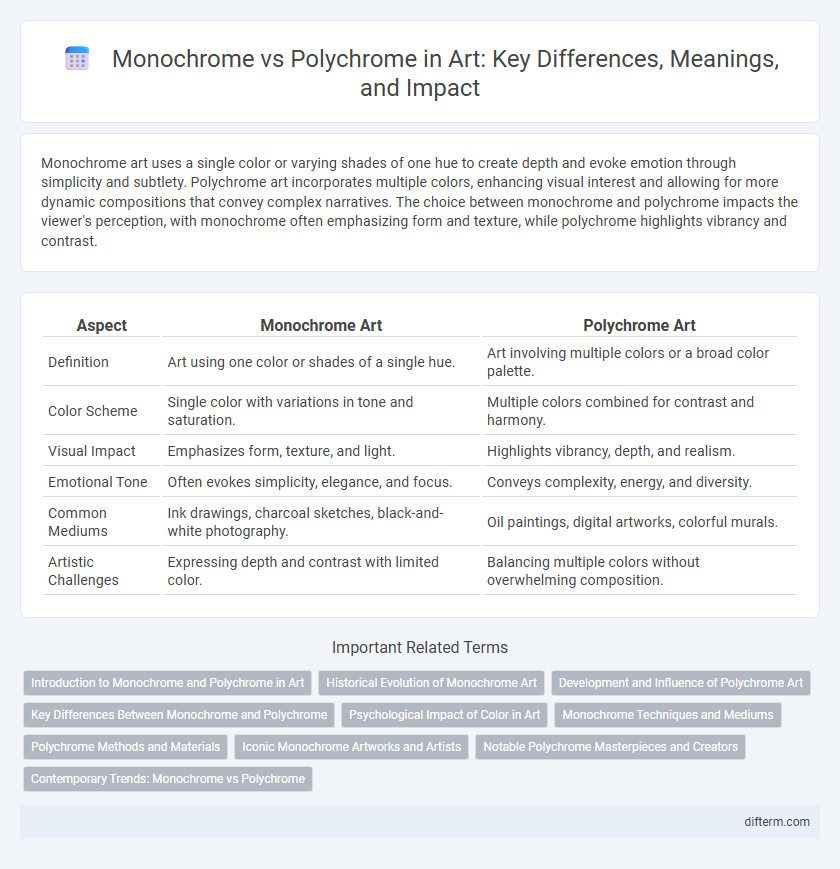Monochrome art uses a single color or varying shades of one hue to create depth and evoke emotion through simplicity and subtlety. Polychrome art incorporates multiple colors, enhancing visual interest and allowing for more dynamic compositions that convey complex narratives. The choice between monochrome and polychrome impacts the viewer's perception, with monochrome often emphasizing form and texture, while polychrome highlights vibrancy and contrast.
Table of Comparison
| Aspect | Monochrome Art | Polychrome Art |
|---|---|---|
| Definition | Art using one color or shades of a single hue. | Art involving multiple colors or a broad color palette. |
| Color Scheme | Single color with variations in tone and saturation. | Multiple colors combined for contrast and harmony. |
| Visual Impact | Emphasizes form, texture, and light. | Highlights vibrancy, depth, and realism. |
| Emotional Tone | Often evokes simplicity, elegance, and focus. | Conveys complexity, energy, and diversity. |
| Common Mediums | Ink drawings, charcoal sketches, black-and-white photography. | Oil paintings, digital artworks, colorful murals. |
| Artistic Challenges | Expressing depth and contrast with limited color. | Balancing multiple colors without overwhelming composition. |
Introduction to Monochrome and Polychrome in Art
Monochrome art utilizes a single color or varying shades of one hue to create depth, texture, and mood, emphasizing form and composition over color diversity. Polychrome art incorporates multiple colors, enhancing vibrancy and complexity, often used to convey emotion, symbolism, and visual interest. Both approaches play critical roles in art history, influencing styles from classical sculpture to contemporary painting.
Historical Evolution of Monochrome Art
Monochrome art, characterized by the use of a single color or shades of one hue, traces its origins back to prehistoric cave paintings where early humans employed limited palettes due to material constraints. In the modern era, artists like Kazimir Malevich and Yves Klein revolutionized monochrome art by emphasizing purity of color and form to challenge traditional representation and evoke emotional responses. This evolution reflects a shift from practical limitations to intentional minimalism, marking a significant moment in art history where simplicity became a powerful mode of expression.
Development and Influence of Polychrome Art
Polychrome art, characterized by its use of multiple vivid colors, developed significantly during the Renaissance, reflecting advancements in pigment technology and artistic techniques. Its influence is evident across various art forms, enhancing emotional expression and cultural symbolism, contrasting the restrained simplicity of monochrome works. The dynamic interplay of hues in polychrome art fostered richer visual narratives, profoundly shaping art movements from Baroque to modern abstract styles.
Key Differences Between Monochrome and Polychrome
Monochrome art utilizes a single color or various shades of one hue to create depth and focus, emphasizing texture and form without the distraction of multiple colors. Polychrome art incorporates multiple colors, enhancing visual complexity and emotional impact through varied color contrasts and harmonies. The key difference lies in monochrome's minimalist color palette fostering simplicity, while polychrome's diverse palette promotes vibrancy and dynamic expression.
Psychological Impact of Color in Art
Monochrome art uses a single color or shades of one hue, creating a focused emotional experience that often evokes calmness, introspection, or solemnity. Polychrome art employs multiple colors, stimulating a broader range of emotions such as excitement, warmth, and vibrancy, influencing the viewer's psychological response through dynamic contrasts and color interactions. The psychological impact of color in art is critical, as monochrome palettes tend to foster meditative or minimalist effects, whereas polychrome palettes engage the brain's perception of complexity and emotional diversity.
Monochrome Techniques and Mediums
Monochrome art emphasizes the use of a single color or shades of one hue to create depth, texture, and contrast, offering a focused visual experience. Techniques such as ink wash, charcoal drawing, and graphite shading highlight tonal variations and intricate detailing without the distraction of multiple colors. Common mediums include charcoal, graphite, ink, and acrylics, each allowing artists to explore light, shadow, and form within a cohesive, unified palette.
Polychrome Methods and Materials
Polychrome art utilizes multiple colors, achieved through diverse methods such as layering pigments, glazing, and mixing media like tempera, oil, or acrylic paints to enhance vibrancy and texture. Artists employ natural pigments like ochres, malachite, and lapis lazuli combined with binders such as egg yolk or linseed oil to create durable, richly colored surfaces. Techniques like encaustic and fresco further expand polychrome possibilities, allowing for dynamic color interplay in sculptures, murals, and decorative arts.
Iconic Monochrome Artworks and Artists
Iconic monochrome artworks such as Kazimir Malevich's "Black Square" and Yves Klein's "Blue Monochrome" highlight the power of singular hues in evoking emotion and conceptual depth. Artists like Malevich, Klein, and Ad Reinhardt revolutionized abstract art by emphasizing purity of color and form, stripping away representational elements to explore visual perception. Monochrome art stands as a critical counterpoint to polychrome works, challenging traditional color dynamics and focusing on minimalism and spatial awareness.
Notable Polychrome Masterpieces and Creators
Polychrome art showcases vibrant color harmonies, evident in masterpieces like Gustav Klimt's "The Kiss" and Frida Kahlo's self-portraits, which utilize bold palettes to convey complex emotional narratives. Renowned creators such as Henri Matisse and Marc Chagall have advanced polychrome techniques, blending hues to evoke mood and cultural symbolism. The dynamic interplay of multiple colors in polychrome works defines expressive diversity, contrasting with the restrained palette of monochrome art.
Contemporary Trends: Monochrome vs Polychrome
Contemporary art trends reveal a dynamic interplay between monochrome and polychrome approaches, where monochrome emphasizes purity and minimalism through single-color compositions, often exploring texture and form. Polychrome, contrastingly, embraces vibrant color palettes to evoke emotional depth and complexity, reflecting multicultural influences and digital aesthetics. These divergent techniques highlight artists' evolving strategies in visual storytelling and conceptual expression within the contemporary art scene.
Monochrome vs Polychrome Infographic

 difterm.com
difterm.com